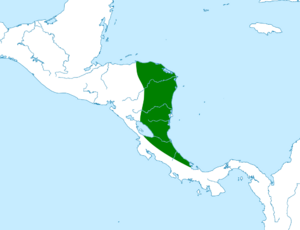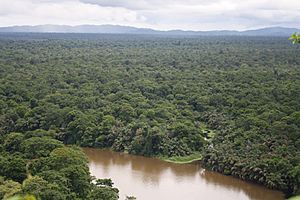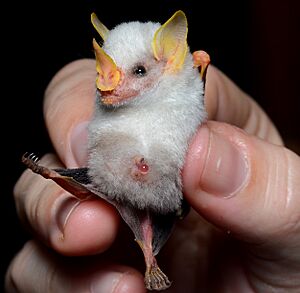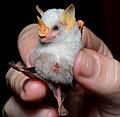Honduran white bat facts for kids
Quick facts for kids Honduran white bat |
|
|---|---|
 |
|
| A roosting colony (Costa Rica) | |
| Conservation status | |
| Scientific classification | |
| Genus: |
Ectophylla
|
| Species: |
alba
|
 |
|
| Range map of the species | |
The Honduran white bat (Ectophylla alba) is a special type of bat. It's also known as the Caribbean white tent-making bat. This bat is the only member of its group, called Ectophylla. Scientists first described this bat and its group in 1892.
What makes it stand out is its bright white fur. Only six out of about 1,300 known bat species have completely white fur! These bats are clever builders. They make "tents" from large plant leaves by carefully cutting the leaf ribs with their teeth. They then rest in these tents during the day.
The Honduran white bat is a picky eater. It mostly eats the fruits of just one type of fig tree. Female bats can likely have babies twice a year, usually one at a time.
You can find these bats in Honduras, Nicaragua, Costa Rica, and western Panama. They live from sea level up to about 700 meters (2,300 feet) high. Sadly, their homes are disappearing. Because of this, the IUCN (a group that tracks animal populations) lists them as "near-threatened."
Their bright yellow ears, nose-leaf, and lips are quite unique. This color comes from special chemicals called carotenoids. Scientists are studying how these bats get their color. This research might help us understand and fight an eye problem in humans called macular degeneration.
Contents
About the Honduran White Bat
The Honduran white bat was first described by an American scientist named Harrison Allen in 1892. He named it Ectophylla alba. The first bat used for this description was found in Honduras in 1887.
This bat belongs to the leaf-nosed bat family, called Phyllostomidae. Within this family, it's part of a smaller group called Stenodermatinae. The Honduran white bat is the only species in its genus, Ectophylla. This means it's a "monotypic genus."
The name "Ectophylla" comes from ancient Greek words. "Ektós" means "out," and "phúllon" means "leaf." This refers to its nose-leaf. Its species name, "alba", comes from Latin and means "white."
What Does the Honduran White Bat Look Like?
As its name suggests, the Honduran white bat has very bright white fur. The tips of its hairs are a bit gray, especially towards its back. This bat is one of only a few known bat species with all-white fur.
Its large nose-leaf helps tell it apart from other white bats, like the northern ghost bat. The northern ghost bat is the only other white bat that lives in the same areas.
The Honduran white bat's wing membranes are black. Its ears, the small cartilage in front of its ear openings (called tragi), nose-leaf, and lips are a bright yellowish-orange. This yellow-orange color comes from a lot of carotenoids, especially a type called xanthophyll. It's the first mammal known to have so many carotenoids in its skin that it creates such a clear color!
Scientists studied the yellow color of their ears and nose-leaves. They found that adult bats have brighter yellow ears than younger bats. For nose-leaves, adult males have brighter yellow ones than adult females. This might mean that females choose mates based on how bright their nose-leaves are. Males with brighter nose-leaves tend to be healthier. So, the nose-leaf color could be an "honest signal" of a male's health.
Another study found that this special yellow color might have developed because of how the bats roost. When sunlight shines through the green leaves of their tents, it creates a yellowish light. Bats with yellowish fur would blend in better, like camouflage. This would help them hide from predators and survive.
This is a small bat. Its head and body are about 37-47 millimeters (1.5-1.9 inches) long. Its forearm is about 27.8-29.3 millimeters (1.1-1.2 inches) long. Its ears are 10-15 millimeters (0.4-0.6 inches) long. These bats weigh only about 5-6 grams (0.18-0.21 ounces). That's about the weight of two pennies!
The bat has an upright nose-leaf. It doesn't have a tail. Its ears are large and round. It also has eight to ten small "warts" under its mouth. It has 28 teeth in total.
Life and Habits
How They Make Tents
The Honduran white bat is one of about 22 known bat species that rest inside leaf "tents." These bats cut the side veins of large Heliconia plant leaves. This makes the leaves fold down to form a tent.
It's likely that more than one bat helps build a tent. Females have been seen building them, and males probably do too. They build new tents all year because changing the leaves into tents makes the leaves die faster. A leaf used as a tent lasts about 7.5 weeks, while a normal leaf can last over a year.
They use several types of Heliconia plants for their tents. Sometimes, they also use Calathea and Ischnosiphon inflatus plants. When choosing leaves, the age and size of the leaf seem more important than the plant species. They prefer leaves that are 0.8-1.2 meters (2.6-3.9 feet) long and less than 30 days old. Younger leaves might be easier to bite and shape.
They also like leaves that are less than 2 meters (6.6 feet) above the forest floor. They choose leaves in areas where there aren't many small plants underneath, but lots of trees above. The trees above help keep the tent's temperature steady. This high tree cover also protects the tent from wind and rain. Building a tent takes a lot of time and effort from several bats. So, choosing a sheltered spot helps the tent last longer.
These bats cling to the roof of their tent in small groups, called colonies. A colony can have 1 to 15 bats. The tent protects them from rain and animals that might try to eat them.
Instead of staying in one tent all the time, Honduran white bats have many tents spread out in the forest. They switch between these tents for resting. Some tents have been used for up to 45 days straight. Even though their tents are low to the ground, sunlight filters through the green leaves. This makes their white fur look greenish, which helps them blend in almost perfectly if they stay still. Another idea is that their white fur makes them look like a wasp nest, which predators would avoid. Their predators likely include capuchin monkeys, Central American squirrel monkeys, and snakes.
What They Eat and How They Find Food
The Honduran white bat is a frugivore, meaning it eats fruit. It's one of the two smallest fruit-eating bats in the world. It mostly eats the fruit of one type of fig tree, called Ficus colubrinae. Sometimes, they also eat other fig species.
These bats prefer F. colubrinae trees that produce a lot of fruit at once. They also choose fig trees that are closest to where they rest during the day. F. colubrinae trees produce fruit all year round, so the bats always have food. Because they eat mostly one type of fig, they travel further to find food than bats that eat many different things. Each bat has a "home range" of about 63.2 hectares (0.24 square miles). It's a bit of a mystery how they survive on such a limited diet.
Reproduction and Life Cycle
Not much is known about how Honduran white bats have babies. It's thought that they give birth in April and September. Pregnant females have been seen in Costa Rica in February, March, June, July, and August. Females feeding their babies have been seen in March and April.
All the females in a colony tend to give birth in the same week. They usually have one baby at a time, called a pup. While feeding their pups, mothers will fly back to their roosts up to six times a night. Pups learn to fly, or fledge, when they are 3–4 weeks old.
Where They Live

The Honduran white bat lives in several countries in Central America. These include Costa Rica, Honduras, Nicaragua, and Panama. It's unusual because it's one of only four types of leaf-nosed bats found only in Central America. Most leaf-nosed bats live in South America.
They live at different heights, from sea level up to 700 meters (2,300 feet) high. They like wet evergreen forests and "secondary forests" (forests that have grown back after being cut down). These types of forests have the right plants for their tents and food.
Protecting the Honduran White Bat
Even though the Honduran white bat has a very noticeable color, scientists didn't find another one for over 60 years after the first discovery in 1898!
Today, the IUCN lists this bat as "near-threatened." This means its population is going down. The decline isn't yet 30% over the last 18 years (which would make it "vulnerable"), but it's getting close.
The main reasons for their population drop are that their homes are being turned into farmland. Also, the human population is growing. These bats are especially at risk because they rely so much on just one type of fig tree for food.
How This Bat Helps Human Health Research
In 2016, scientists found out that the Honduran white bat uses carotenoids to make its ears, nose-leaf, and lips yellow-orange. It was the first mammal found to have so many carotenoids that they create a visible skin color.
The bat gets these pigments from its diet, especially from the fruits of the Ficus colubrinae tree. A specific carotenoid called Lutein gives it the yellow color. In the bat's skin, lutein is in a special form called "esterified," but in its liver, it's in a "free" form. This suggests that Honduran white bats have a way to change free lutein into esterified lutein, which humans can't do.
Lutein is very important for our eyes because it helps protect the retina from damage. Scientists think that if the free lutein in human eyes could be changed to the esterified form, it might protect our vision even better. Understanding how these bats do this could help us learn more about how carotenoids benefit human health. This research might even help in understanding and treating an eye disease in humans called macular degeneration.
Images for kids









